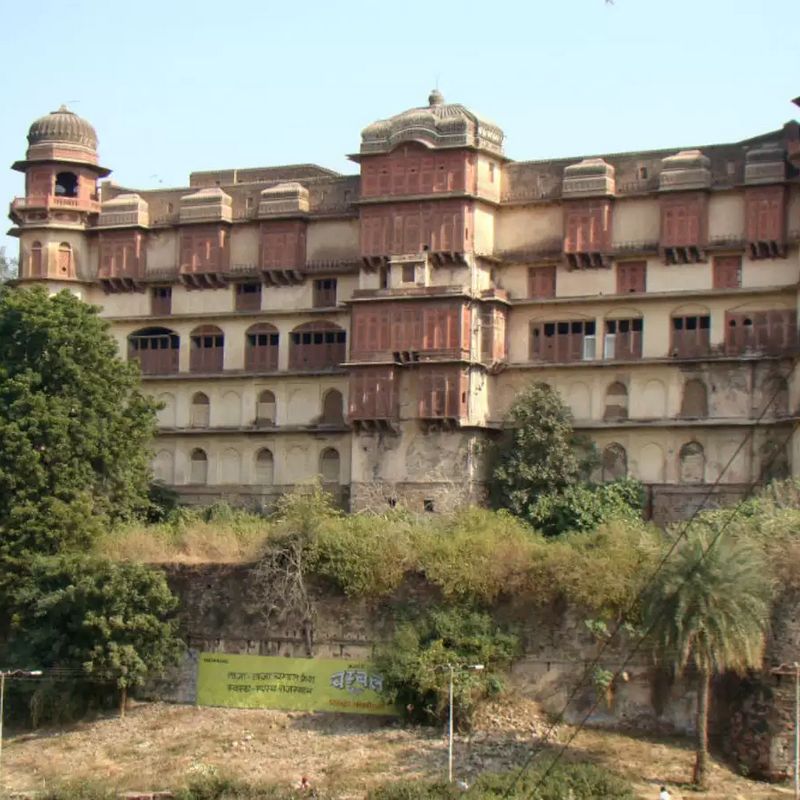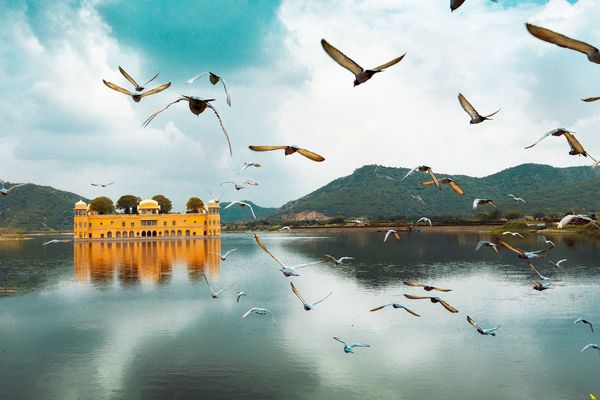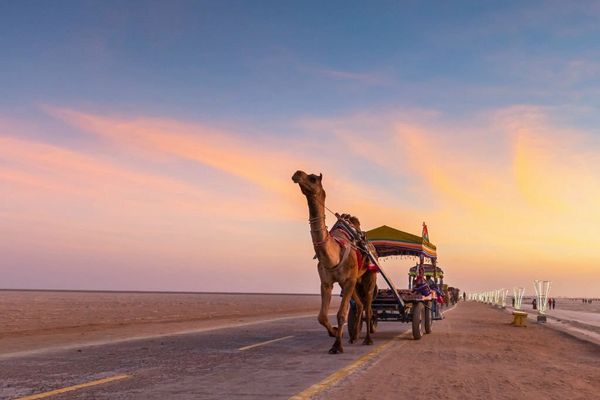BIKANER
Rajasthan, India
About Bikaner
Explore the bustling local markets of Bikaner, such as Kote Gate and Bada Bazaar, where the fragrance of authentic spices fills the air, and the lively banter of vendors enlivens the atmosphere. Savor the city’s culinary masterpieces, including the renowned bhujia and rasgulla, offering a feast that enhances Bikaner’s cultural mosaic.
Seek tranquility at the unique Rat Temple, a sanctuary celebrating the mystical bond between humans and animals. Witness the grandeur of the Indo-Saracenic Lalgarh Palace, revealing Bikaner’s regal heritage. Enjoy the serene beauty of Gajner Palace, a lakeside gem that reflects the splendor of its illustrious past.
Experience Bikaner’s soul through folk performances and traditional music at Laxmi Niwas Palace. The city’s festivals, particularly the colorful Camel Festival, bring a dynamic spectrum to your cultural journey. Bikaner emerges as an enchanting destination, beckoning you to immerse in its cultural wealth and natural beauty, now enriched with tiger safari and cultural tours in India, including the thrilling tiger safari in India, adding an adventurous dimension to your exploration.
highlights
- Junagarh Fort: Majestic, unconquered fortress with exquisite architecture
- Karni Mata Temple: Known for sacred rats, a unique Hindu pilgrimage site.
- Laxmi Niwas Palace: Opulent royal palace turned heritage hotel
- Gajner Palace: Serene lakeside retreat in a historic palace setting.
- Devi Kund: Ornate cenotaphs and chhatris, a royal crematorium site.
- Rajasthan State Archives: Repository of historical documents and manuscripts
- Jorbeed: A charming desert village with glimpses of traditional Rajasthan.
Places to visit in Bikaner
1. Junagarh Fort
Junagarh Fort, a formidable and magnificent structure, stands proudly in the heart of Bikaner, Rajasthan, India. This architectural marvel is a testament to the opulence and grandeur of the Rajput dynasty and is one of the few forts in Rajasthan that was never conquered.
Built in the 16th century by Raja Rai Singh, a trusted general in the Mughal Emperor Akbar’s army, the fort showcases a splendid fusion of Mughal, Rajput, and Gujarati architectural styles. The intricate stone carvings, ornate balconies, exquisite frescoes, and intricately decorated courtyards within the fort complex are a visual delight.
Inside the fort, visitors can explore numerous palaces, including the Anup Mahal, Phool Mahal, and Ganga Niwas. Each palace reveals a unique facet of Rajput lifestyle, showcasing their love for art, culture, and extravagance.
Junagarh Fort also houses a museum that exhibits an impressive collection of weaponry, armor, and artifacts, offering valuable insights into Rajasthan’s rich history and martial traditions.
This majestic fort is a must-visit for history enthusiasts and architecture aficionados, providing a glimpse into the regal past of Rajasthan and the indomitable spirit of its rulers.

2. The National Research Centre On Camel (NRCC)
The National Research Centre on Camel (NRCC) is a pioneering research institution located in Bikaner, Rajasthan, India, dedicated to the conservation and development of camels. Established in 1984, NRCC plays a pivotal role in understanding, preserving, and promoting the importance of camels, particularly in arid and semi-arid regions.
Camels have been an integral part of Rajasthan’s culture and economy for centuries, serving as essential beasts of burden, transportation, and sources of livelihood. NRCC’s mission is to advance camel research, breeding, nutrition, and health to enhance their productivity and sustainability.
The center conducts extensive research on camel genetics, reproduction, and disease management, aiming to improve the camel population’s overall health and well-being. NRCC also serves as a resource for camel owners and herders, offering valuable insights and training to optimize camel husbandry practices.
In addition to its research activities, NRCC welcomes visitors and tourists, providing them with the opportunity to learn about camels, their role in the region, and the conservation efforts being undertaken. The center is a symbol of Rajasthan’s rich heritage and its commitment to preserving this unique and resilient desert animal.

3. Lalgarh Palace & Museum
Lalgarh Palace & Museum, located in Bikaner, Rajasthan, is a magnificent architectural masterpiece that stands as a testament to the grandeur and opulence of the region’s royal heritage. Built in the early 20th century by Maharaja Ganga Singh, the palace is a remarkable blend of Rajput, Mughal, and European architectural styles.
The palace’s red sandstone façade, intricate latticework, and beautifully landscaped gardens exude regal charm. Inside, the museum offers a captivating glimpse into Bikaner’s history, featuring a vast collection of artifacts, including royal memorabilia, weaponry, and artworks.
One of the highlights is the “Sadul Singh Museum,” showcasing personal possessions of the erstwhile Maharaja and his family. The museum also houses an extensive library with ancient manuscripts and historical documents.

4.Rampuria Haveli
Rampuria Haveli is a striking architectural gem located in the heart of Bikaner, Rajasthan, India. This historic mansion stands as a testament to the opulent and artistic heritage of the region. Built during the late 18th and early 19th centuries, the haveli was the residence of the wealthy Rampuria family, who were prominent merchants and traders.
The haveli is renowned for its intricate and ornate architecture, characterized by stunning frescoes, exquisite jharokhas (balconies), and finely carved wooden facades. The designs on the walls depict scenes from mythology, local folklore, and everyday life, showcasing the artistic prowess of the craftsmen of that era.

5. Ganga Government Museum
The Ganga Government Museum, situated in Bikaner, Rajasthan, India, is a cultural treasure trove that provides insights into the rich history and heritage of the region. Founded in 1937, this museum is named after Maharaja Ganga Singh, a visionary ruler of Bikaner, who played a pivotal role in its establishment.
The museum houses an extensive collection of artifacts that span various aspects of Rajasthani culture and history. Visitors can explore exhibits on archaeology, art, weaponry, textiles, and ethnography, with a focus on showcasing the opulence and traditions of the princely state of Bikaner.
One of the museum’s standout features is its collection of Rajasthani miniature paintings, which vividly depict mythological and historical events. Additionally, the museum’s arms and armor section showcases an impressive array of ancient weaponry and armor worn by Rajput warriors.

6.Laxmi Nivas Palace
Laxmi Niwas Palace, located in Bikaner, Rajasthan, is a magnificent architectural marvel that exemplifies the opulence and grandeur of Rajasthan’s royal heritage. Constructed in the Indo-Saracenic architectural style during the late 19th century, this palace was designed by Sir Samuel Swinton Jacob and commissioned by Maharaja Ganga Singh.
The palace’s stunning red sandstone façade is adorned with intricate lattice work, ornate balconies, and exquisite carvings. Its interiors are equally opulent, with splendidly decorated halls, magnificent chandeliers, and a regal ambiance that transports visitors to a bygone era.
Today, Laxmi Niwas Palace has been transformed into a luxurious heritage hotel, offering guests a chance to experience the regal lifestyle of the past while enjoying modern comforts. The palace’s lush gardens, elegant courtyards, and meticulously preserved interiors make it a popular destination for tourists seeking a royal retreat in Rajasthan.

7. Karni Mata Temple
The Karni Mata Temple, located in the small town of Deshnoke in Rajasthan, India, is a unique and fascinating Hindu temple known for its extraordinary residents—thousands of rats that are revered and considered sacred. This temple, also known as the “Temple of Rats,” draws devotees and curious travelers alike.
The temple is dedicated to Karni Mata, a Hindu sage believed to be an incarnation of Goddess Durga. Legend has it that when the stepson of Karni Mata drowned, she appealed to Yama, the god of death, to revive him. Yama agreed, and from that point on, Karni Mata’s family members and devotees are believed to be reincarnated as rats in the temple.

8. Gajner Palace & Lake
Gajner Palace, a splendid royal heritage hotel, is located near the charming Gajner Lake in the desert city of Bikaner, Rajasthan, India. This magnificent palace was built in the early 20th century by Maharaja Sir Ganga Singh of Bikaner as a hunting lodge and a retreat for royalty.
The palace, set against the backdrop of the serene Gajner Lake and surrounded by lush greenery and wildlife, offers a tranquil and picturesque escape from the bustling city. Its stunning red sandstone architecture, intricate carvings, and beautifully landscaped gardens exude regal charm.

9. Devi Kund
Devi Kund, located near Bikaner, Rajasthan, is a royal crematorium known for its intricate cenotaphs and chhatris. It is a serene and historic site where the Bikaneri royals have been cremated for centuries, featuring stunning Rajput architecture and an aura of solemnity.

10. Rajasthan State Archive
The Rajasthan State Archives, situated in Bikaner, India, is a repository of historical documents, manuscripts, and records. It holds a rich collection of historical records that provide valuable insights into Rajasthan’s heritage, making it a vital resource for researchers, historians, and those interested in the region’s history and culture.

11. Garh Palace
Garh Palace is a sprawling complex in Bundi featuring a blend of Rajput and Mughal architectural elements. It houses several palaces, courtyards, and colorful frescoes that showcase the opulence of Bundi’s royalty.

12. Jorbeed
Jorbeed is a small village located in the Bikaner district of Rajasthan, India. While it may not be widely recognized, it holds historical and cultural significance due to its location in the heart of the Thar Desert. Visitors can experience traditional Rajasthani life and enjoy the desert’s natural beauty.

Top Accommodations in Bikaner

Laxmin Niwas Palace

Brij Gaj Kesri
...and more
Explore Around Bikaner

Gajner Wildlife Sanctuary

Jaisalmer

Jaipur
...and more
Celebrate in Bikaner
Best Time to Travel to Bikaner
Discover Bikaner’s vibrant cultural tapestry during its prime travel window from October to March. This period offers a perfect blend of mild weather and lively festivals, enhancing your cultural tours in Bikaner. Explore the majestic Junagarh Fort, witness the opulent Karni Mata Fair, and savor local delicacies against the backdrop of Rajasthan’s rich heritage. This season ensures an enchanting experience, where the city’s historical treasures come alive, making it the best time for a memorable cultural sojourn in Bikaner.
Reaching Bikaner
Air : Traveling to Bikaner by air is convenient, with the nearest airport being Nal Airport (BKB). Situated approximately 13 kilometers away from the city center, Nal Airport connects Bikaner to major Indian cities. Domestic flights operate regularly, ensuring a swift and comfortable journey for visitors arriving by air.
Train : Bikaner boasts a well-connected railway network, making train travel an efficient option. Bikaner Junction is the primary railway station, linking the city to various destinations across India. Numerous trains, including express and superfast services, provide accessibility to and from Bikaner, offering a scenic and hassle-free journey for those who prefer traveling by train.
Road : For those who enjoy road trips, Bikaner is well-connected by an extensive network of roads and highways. The city is easily accessible by bus or car, with regular bus services from neighboring cities and towns. The road journey offers a chance to witness the diverse landscapes of Rajasthan and is a convenient option for travelers who prefer the flexibility of their own transportation.
GET A FREE QUOTE
Feel free to get in touch with our team of wildlife experts and receive a free quote for your next tiger safari holiday! You could also use this channel to request for a custom wildlife holiday package in India!
The Bikaner Gallery
Suggested Tours
India Classic Journeys
Discover the vibrant tapestry of Gujrat’s cultural heritage on a captivating tour. Immerse in traditional arts, music, and dance, as you explore historical landmarks and savor authentic Gujarati cuisine. Witness the grandeur of festivals and craftsmanship that define this unique region, making it a must-visit cultural destination.
Destinations Covered
- Ahemdabad
- Chotta Udaipur
- Posina
- Dasada
- Bhuj
- Gondal
India Classic Journeys
Experience the Heart of Rajasthan on a captivating tour through the royal state of India. Immerse yourself in the opulent heritage, explore majestic palaces, and vibrant bazaars. Witness the desert’s allure, enjoy authentic cuisine, and admire architectural wonders. This tour blends culture, history, and adventure, offering an unforgettable journey.
Destinations Covered
- Delhi
- Jaisalmer
- Jodhpur
- Udaipur
- Bundi
- jaipur
India Classic Journeys
Embark on the opulent Luxury Golden Triangle Tour in India, a captivating journey through Delhi, Agra, and Jaipur. Immerse in lavish comforts at iconic hotels, marvel at historical wonders like the Taj Mahal, and indulge in gourmet delights. A perfect blend of luxury, history, and cultural richness awaits.
Destinations Covered
- List Item #1
- List Item #1
- List Item #1
- List Item #1
- List Item #1
- List Item #1
Related Destinations
Frequently Asked Questions
ome of the must-visit cultural destinations in India during your cultural and wildlife tour include the Taj Mahal in Agra, Jaipur’s palaces and forts, Varanasi’s spiritual sites, and the cultural heritage of cities like Delhi and Udaipur. For wildlife enthusiasts, national parks like Ranthambore, Kaziranga, and Jim Corbett offer incredible biodiversity.
The ideal time for a cultural and wildlife tour in India depends on your preferences and the regions you plan to explore. Generally, the winter months (October to March) offer pleasant weather for most parts of India. However, wildlife enthusiasts may prefer visiting national parks during the cooler months, while cultural tours can be enjoyed year-round.
India boasts incredible wildlife diversity. During wildlife tours, you can spot iconic species like Bengal tigers, Indian elephants, Indian rhinoceroses, leopards, and various bird species. Each national park and region has its unique fauna and flora, making India a wildlife enthusiast’s paradise.
Yes, cultural and wildlife tours in India can be family-friendly. Many tour operators offer family-oriented itineraries that include educational activities and interactions with local communities. However, it’s essential to consider the age and interests of your children and choose destinations and activities accordingly.
Packing essentials for a cultural and wildlife tour in India include comfortable clothing suitable for the season and region you’re visiting, sturdy walking shoes, insect repellent, sunscreen, a hat, a reusable water bottle, a camera with extra batteries, any necessary medications, and a power bank for charging electronic devices. Additionally, it’s wise to check specific packing recommendations with your tour operator based on your itinerary.




